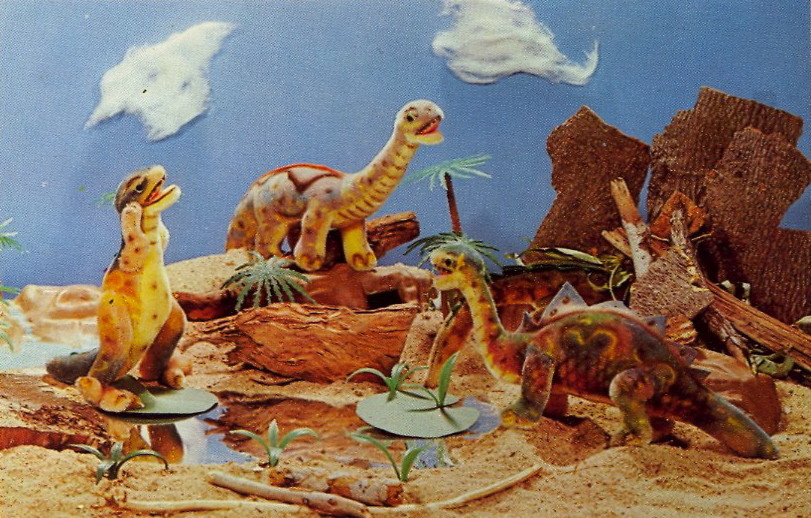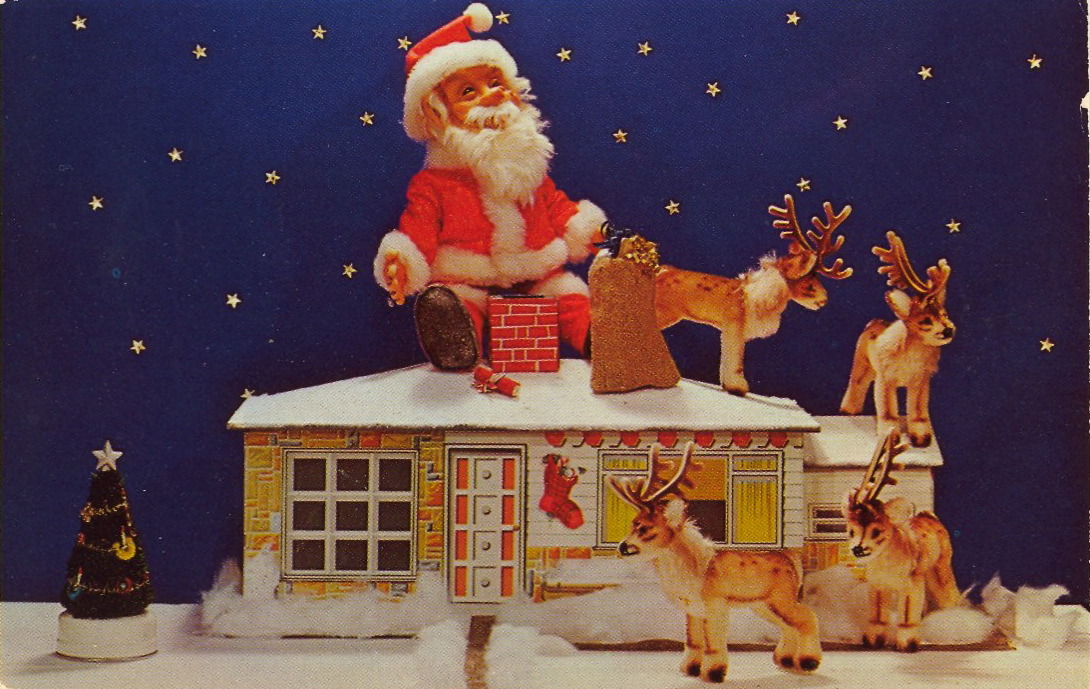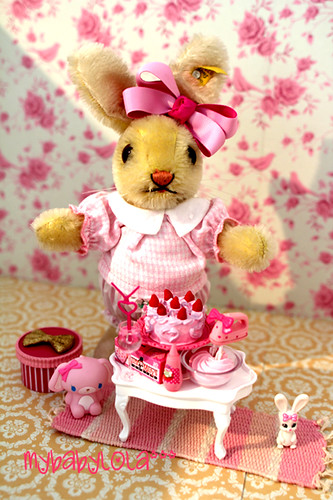Steiff
 |
Richard Steiff introduced the
'button in ear' trademark in 1905
to reduce competition from inferior
knock-offs. |
First (and this is the main reason) I really, really like Steiff. I have been collecting Steiff toys all of my life and have at least 500 animals from every decade of the company's existence.
Second, Margarete Steiff and her company's history are pretty interesting. She basically invented the stuffed toy as we know it and her nephew brought us the teddy bear. For this reason I think it's fair to say that the world would be missing some pretty great toys if it were not for Margarete Steiff.
Third, Steiff toys are to die for cute. This means there loads of great photos to look at. Below you'll find few of my favorites alongside some interesting facts about Steiff and it's history.
Early History
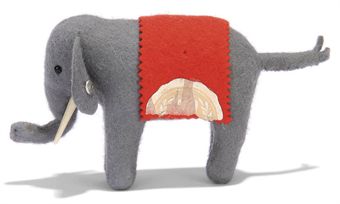 |
A replica of the first Steiff pin cushion.
This little elephant was produced in 1930 to commemorate Steiff's first 50 years. This particular toy realized $950 at Christie's in 2010. |
The Steiff story begins in 1880, when dressmaker Margarete Steiff inadvertently invented the first stuffed toy by sewing scraps of felt together into the shape of a tiny elephant. She originally intended to give this elephant, as well as other toys like it, as gifts of appreciation to the families she worked for. But her animals soon became so popular (both as toys and as pin cushions) she and her brother Fritz ended up selling them to customers who were willing to pay.
By 1889, Margarete Steiff was mass producing her small toys in her own factory in Geingen am Brenz, Germany. This was quite an accomplishment, considering that she was a woman AND she had to conduct all of her business from a wheelchair (Margarete had polio when she was two). Although her brother Fritz helped out with the finances, Margarete single-handedly managed the design and production of the toys. Guided
by the motto – ‘only the best is good enough’ – Margarete insisted
that her toys be made from the highest grade felt and be stuffed with lamb’s wool
and/or excelsior (fine wood shavings). These expensive materials allowed her to mold the toys into imaginative poses that could endure
many hours of play. In 1892, Margarete Steiff published her first catalogue of patented toy animals that included monkeys, elephants, donkeys,
pigs, mice, dogs, cats, rabbits, horses and a giraffe.
International Success
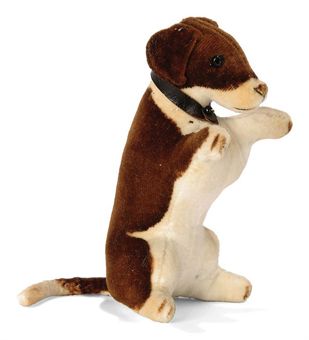 |
A felt Steiff dachshund thought to be
manufactured in 1902. This toy made
$1,781 at the Christie's 2010 auction.
|
By the early 1900’s, Margarete Steiff’s nephews (the three eldest sons of Fritz) were actively involved in the management of their aunt’s growing business. Paul (the eldest)
was responsible for making the patterns and marketing the toys, while
Franz oversaw the day-to-day work at the factory and the weaving of the fabrics. These
fabrics included mohair (a silk-like material made from the hair of an Angora goat), which gradually replaced the wool felt to make the animals look more realistic.
 |
| A replica of one of Richard Steiff's first bears displayed at the Steiff museum. It is believed that this bear represents the design of the 3,000 bears originally sold to Hermann Berg in 1903. |
It was ultimately the work of Margarete's nephew Richard, however, that
rocketed Steiff into international fame. In 1902, Richard developed a new line of toys with his aunt's approval that
was based on his sketches of animals at the Stuttgart zoo. Unlike Margarete's previous designs, Richard’s
animals had jointed limbs and heads, making it possible to pose them in different positions. This series included a popular toy bear that resembled the dancing bears performing in German circuses.
 |
The teddy bear craze originally started
with Clifford Berryman's Washington Post cartoon of Roosevelt refusing to shoot a
cuddly bear cub.
|
1902 was also the year that US president Teddy Roosevelt made
headlines for sparing a bear cub on a hunting trip. Clifford Berryman famously depicted this event in a cartoon with Roosevelt refusing to shoot a cuddly baby bear. The story and the cartoon quickly captured America's imagination, resulting in Berryman including bear cubs in all his cartoons of the president. Shortly thereafter, American toy buyer Hermann Berg saw a potential for bear toys in the US market and placed an order for 3,000 of Richard's jointed bears at the 1903 Leipzig Toy Fair.
 |
| A picture of Margaret Steiff in 1908 with an early dressed bear. |
By 1906, the United States and England were in the full throes of 'Teddy's bear' fever. Although other manufacturers were also producing toy bears by then, only those by Steiff had the patented joint mechanism that customers loved. In
1907, Steiff produced and sold a record 975,000 bears. In 1908, Steiff expanded their product range to offer bears for every taste and budget. By 1909, customers could choose from red bears and blue
bears, puppet bears and muzzle bears, bears that wore clothes and bears that
could do somersaults.
 |
This is "Elliott", a blue Steiff bear
that sold for approximately $75,000 at Christie's in 1993. |
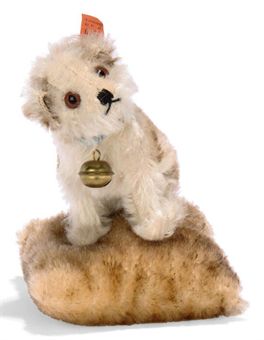 |
This 1920's Molly dog on a
cushionsold for $1,175 at the Christie's 2010 auction. |
Teddy Bears were not the only reason for Steiff's international success. In 1910, the company was awarded the Grand Prix at the World Exhibition in Brussels for its fantastic showpiece display of the best of their product line. By this time, Steiff's catalogue included most zoo animals, a complete circus and an entire working farm. Throughout the teens and 20's, Steiff also produced a diverse range of cats and dogs that were always extremely popular. Case in point was their little dog "Molly", who created her own toy craze when she was first introduced in 1925.
1945 - to the present
 |
Mecki and his wife Micki, with their children Mucki (the girl)
and Macki (the boy)
|
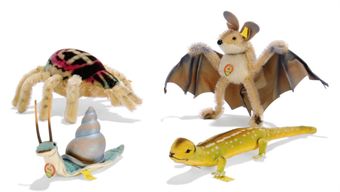 |
A spider, bat, snail and lizard produced by Steiff in the early 60's.
These four animals realised $1,286 at Christies in 2010. |
By the mid 1960's, Steiff was back at peak production with a
highly varied range of creatures that included sea
horses, bats, spiders and dinosaurs. Steiff’s success came to a halt in the mid-70’s, however, when their
trademark mohair animals were no longer competitive against synthetic toys made more cheaply in China.
Steiff responded to this slump by re-inventing themselves once again with a new line of floppy plush toys made from synthetic fabrics. In the early 1980's, Steiff also introduced a series of limited edition mohair replicas of earlier toys to commemorate their first 100 years. In recognition of this important birthday, Steiff built its own "World of Steiff" museum to chronicle its history and showcase some of its greatest achievements.
In 1992, Steiff created the Steiff Club for collectors and fans of their toys. For a modest annual fee, members receive a quarterly newsletter, a toy (typically a small mohair bear) and the opportunity to purchase exclusive limited edition pieces. In the summer of 1997, Steiff hosted its first annual Steiff Festival in Geingen, where collectors have further opportunities to buy exclusive toys and bid on historical pieces at a "Steiff-only" toy auction.
 |
| A selection of Steiff toys made in the 1970's entirely of dralon |
Steiff responded to this slump by re-inventing themselves once again with a new line of floppy plush toys made from synthetic fabrics. In the early 1980's, Steiff also introduced a series of limited edition mohair replicas of earlier toys to commemorate their first 100 years. In recognition of this important birthday, Steiff built its own "World of Steiff" museum to chronicle its history and showcase some of its greatest achievements.
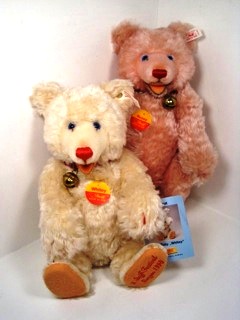 |
Steiff Whitey and Rosie, exclusives
from the 1997 and 98 Steiff festival.
|
 |
Steiff's current product range includes
exotic animals, such as this tarsier. |
Steiff’s current product range includes a mixture of mohair
and synthetic toys that are still produced exclusively at the Geingen factory. This range features expensive limited
edition replicas targeted at adult collectors, as well as cheaper and cuddlier stuffed
toys for children. Steiff takes particular pride in their highly diverse product line, which includes both exotic and common animals. Steiff also currently offers a range of children's clothing and baby toys. The company is still privately owned and employs approximately 1,000 workers. In 2011, the company produced over 1.5 million toys, with an annual turnover of 116 million DM. Two-thirds of these sales were from the German market and one-third were from international sales.
What makes Steiff great?
Educational benefits
 |
This pajama-clad teddy is
well-suited for teaching children
dressing and bed time routines
|
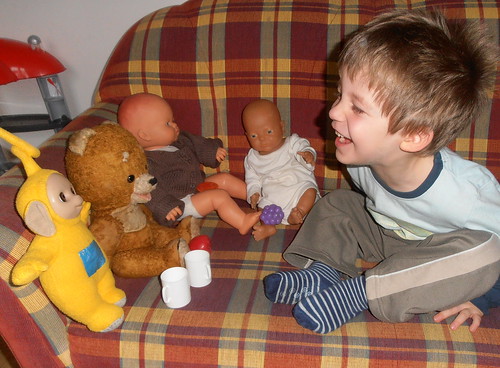 |
| 'Coffee Break' by altipapa |
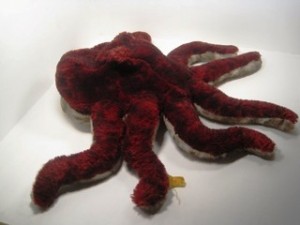 |
| A Steiff octopus, produced in the 90's |
Entertainment value
The Story of Jocko
 |
| Early Steiff pre-button monkey |
A key secret to Steiff's success is their ability to produce endearing and entertaining toy personalities. Jocko the chimp is a perfect example of a Steiff personality who has been entertaining fans for over 100 years. Jocko's roots were established in 1892, when Margarete designed several small monkeys made largely of felt. These toys were the most popular in the Steiff catalogue, despite their primitive workmanship.
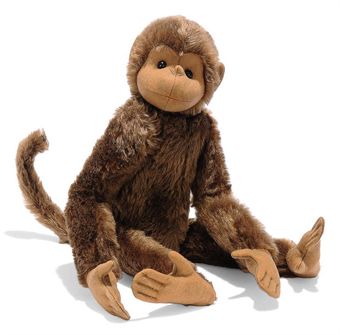 |
This 1905 Steiff monkey sold for
$1,187 at Christies in 2010. |
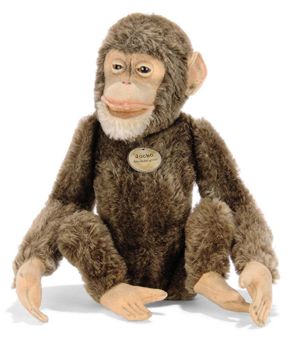 |
A 1910 Steiff Jocko. This toy sold
for $396 at Christies in 2010. |
In 1909, Steiff introduced an ape toy named Jocko who was, without question, a chimpanzee. This fellow was far more realistic than earlier Steiff monkeys, but was equally, if not more, charming . Part of his charm was due to his realistic glass eyes that were delicately sewn into raised felt eyelids. This intricate facial construction resulted in no two Jockos looking exactly the same.
 |
| A "Record Peter" from the 1950's |
Character toys
 |
This 1932 Record Micky Mouse
sold for $1,682 at Christie's in 2010. |
Toys that entertain
 |
The bespeckled Mister Bunny Rabbit
on the Captain Kagaroo show was a Steiff glove puppet. |
 |
| Edith, the 'lonely doll' seated with a Steiff Jackie, waiting for the rain to stop. |
Since 1911, Steiff toys have also been entertaining children through large mechanical showpiece displays that appear in department stores around Christmas or Easter. The primary aim of these showpieces is to attract customers and promote Steiff's current range. Stores can either borrow a small showpiece for their shop window or commission a larger showpiece for a very special event.
The animals in these showpieces are typically arranged in funny situations where they are working and playing together. Below is a video of the Steiff 2011 Weihnachtszuaber display at the Galeria Kaufhauf in Munich, Germany.
Cool factor
The adult toy market
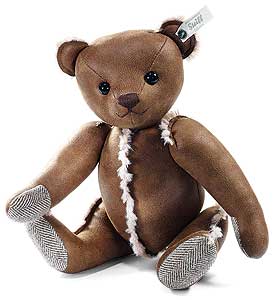 |
A leather Steiff from the current
"Enchanted" collection made for adults. |
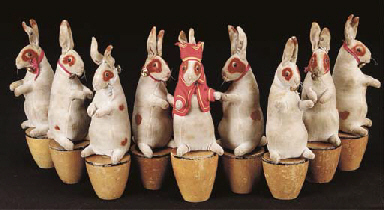 |
This 1906 set of Steiff skittles sold for $11,2004 at
Christie's in 2003.
|
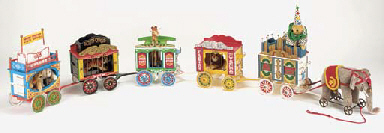 |
| Steiff created this limited edition circus train for adult collectors in the mid-80's. This particular train was sold at Christies in 2002 for $1,647 in 2002. |
As antique toy values steadily increased, Steiff speculated that some adults might be willing to pay a premium for a new toys that had the potential to increase in value. Steiff therefore issued several expensive, limited edition toys based on historically important designs. By the end of the 1980's, more than 30% of the Steiff product line was purchased by adults for adults.
Steiff at auction
 |
This one of a kind Louis Vuitton Steiff
bear made headlines when it realised $191,000 at auction in 2000. |
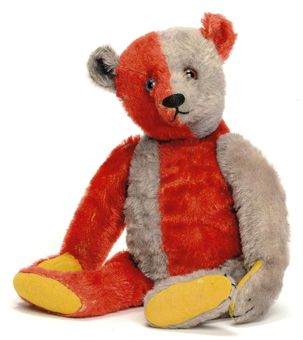 |
| This 1925 special edition harlequin bear made over $90,000 when it was sold at auction in 1999. The final bidder paid just over $74,000 when it came up for auction again in 2010. |
 |
Condition, condition, condition!
This 3" Teddy Baby sold for $11,873 at Christies in 2010. Similar teddy's in worn condition can still be found on eBay for $500 or less. |
It should also be kept in mind that not all antique Steiff toys are so expensive. Factors that drive the value of an antique Steiff include its scarcity and condition. Buyers will also pay a premium for a toy's personality. A comparison of two 1930's teddy babies sold at Christie's in 2010 illustrates this point. Both were in perfect condition with their tags and buttons completely in tact. Both were also cute, but one was exceptionally cute. The exceptionally cute bear sold for $11,873, while the second bear sold for $1,979. Similar teddy babies without their button or tag continue to be sold on eBay for $500 or less.
Hot factor
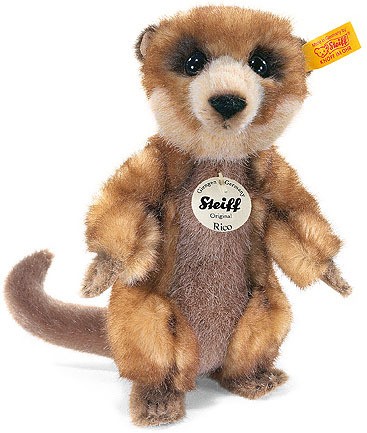 |
This Steiff meerkat is currently
one of Steiff's best selling toys. |
While Steiff animals are not responsible for any current toy crazes, there are clearly a few best sellers. These include a cuddly toy meerkat and 'Flaps' the baby penguin. Best-selling limited editions include characters from the Wizard of Oz story and and a series of girl bears made of felted mohair.
Timelessness
 |
Old vs. new: A Steiff bear belonging to a woman born in the 1960's reads a book to her son's teddy, produced in the 90's.
|
Steiff has been producing toys for over 130 years, making it one of the oldest toy companies in existence. Steiff's longevity, along with their toys' high value on the secondary market, has resulted in a growing number of families sharing multigenrational collections between grandparents, parents and children.
The Steiff photo gallery
Some of the best photographs of Steiff toys appear in postcards published to promote the firm's toys. Below are three of my favorites.
The Flickr photo sharing site is also a great place to find good photos of Steiff toys.
Ellie, by mybabyLola *preparing for tomorrow's pink shoot*
 |
| Mrs. Nila and Mr. Nilo having breakfast, by moline |
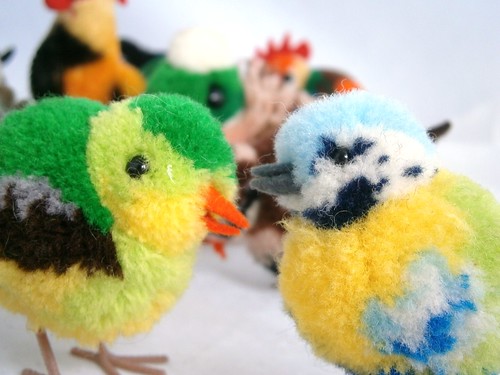 |
| Two Steiff Pom Pom birds by adore62 |
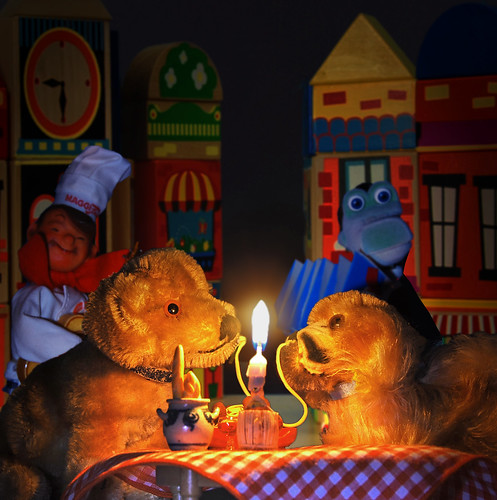 |
| Lady and the Tramp, by Gnome Girl! |
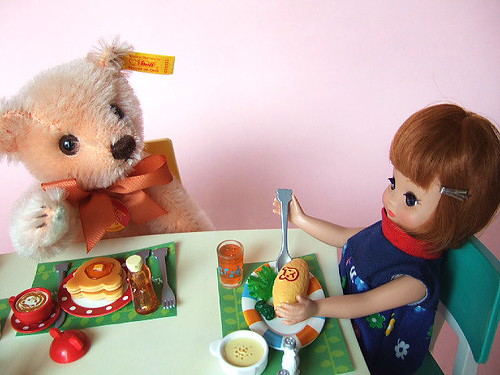 |
| Luncheon Party, by kana* |
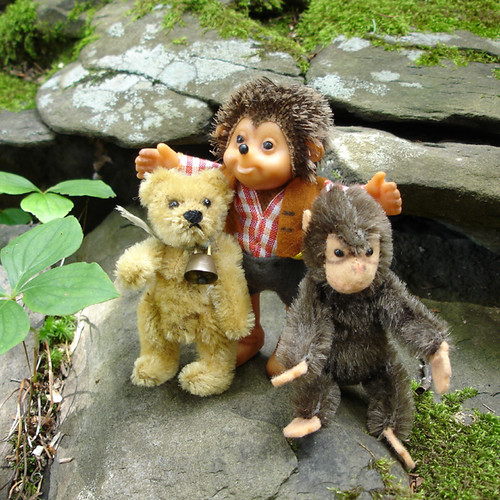 |
| Friends, by TK Richel |
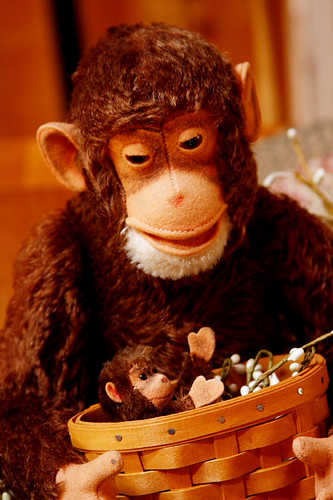 |
| Jocko Monkeys, by WilzDezign |
 |
| Maus, 1997. By Wolfgang Tillmans |
 |
| 1957 Drei M Puppenfabrik by diepuppenstubensammlerin |
 |
| Bed Time Story, by Gnome Girl! |
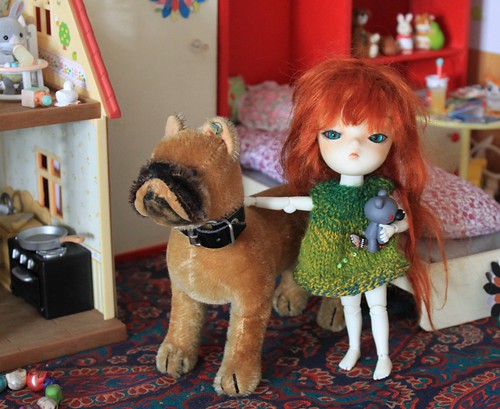 |
| horsey? by Jewel of Hope* . . . physically back |
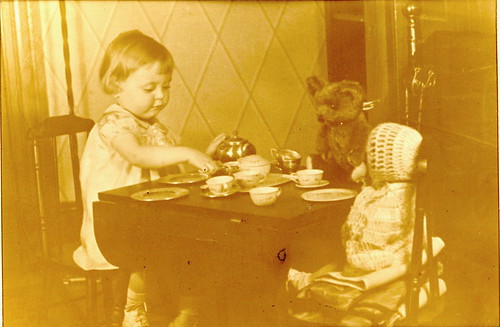 |
| Tea Party with Friends, by Mirror Image Gallery |
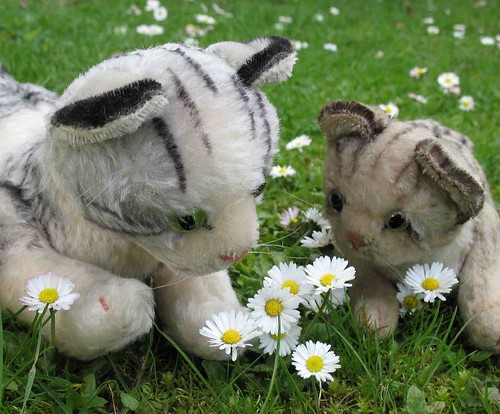 |
| Steiff cats in the Spring by Halloween Fans |
Further information
Books about Steiff:
Cieslik, J. and Cieslik, M. (1994). Steiff Teddy Bears: Love for a Lifetime. Düsseldorf, Germany: Marianne Cieslik Verlag
Cieslik, J. and Cieslik, M. (1989). Button in Ear: The History of the Teddy Bear and his
Friends. Düsseldorf, Germany: Marianne
Cieslik Verlag.
General information on Steiff:
The Steiff company's US website:
http://www.steiffusa.com/
The Steiff company's European website:
http://www.steiff.com/
Wikipedia entry on the Steiff company:
Wikipedia entry on Teddy
bears:
Wikipedia entry on stuffed toys:
http://en.wikipedia.org/wiki/Stuffed_toy
Excellent Martha Stewart video on Steiff:
My Steiff Life blog:
Current information about the Steiff company and collecting Steiff animals:
Information on the Steiff company's history:
http://www.steiffteddybears.co.uk/more-things-steiff/history-of-steiff-bears.php
Steiff production in China:
BBC article on the mystery of the first 3,000 Steiff teddy bears:
Information on collecting Steiff and auction news:
News
coverage of Christie’s auction:
http://www.dailymail.co.uk/news/article-1318911/Steiff-teddy-bear-auction-Christies.html
Forbes article on investing in Steiff:
A list of the most expensive teddy bears sold at
auction:
http://www.mibepa.info/tb/tb005.htm
Stuffed toys and children's development:
Comfort toys in children’s development:
http://www.parents.com/toddlers-preschoolers/development/behavioral/lovey/
An article on the benefits of stuffed toys: http://voices.yahoo.com/developmental-benefits-associated-stuffed-or-9452041.html



